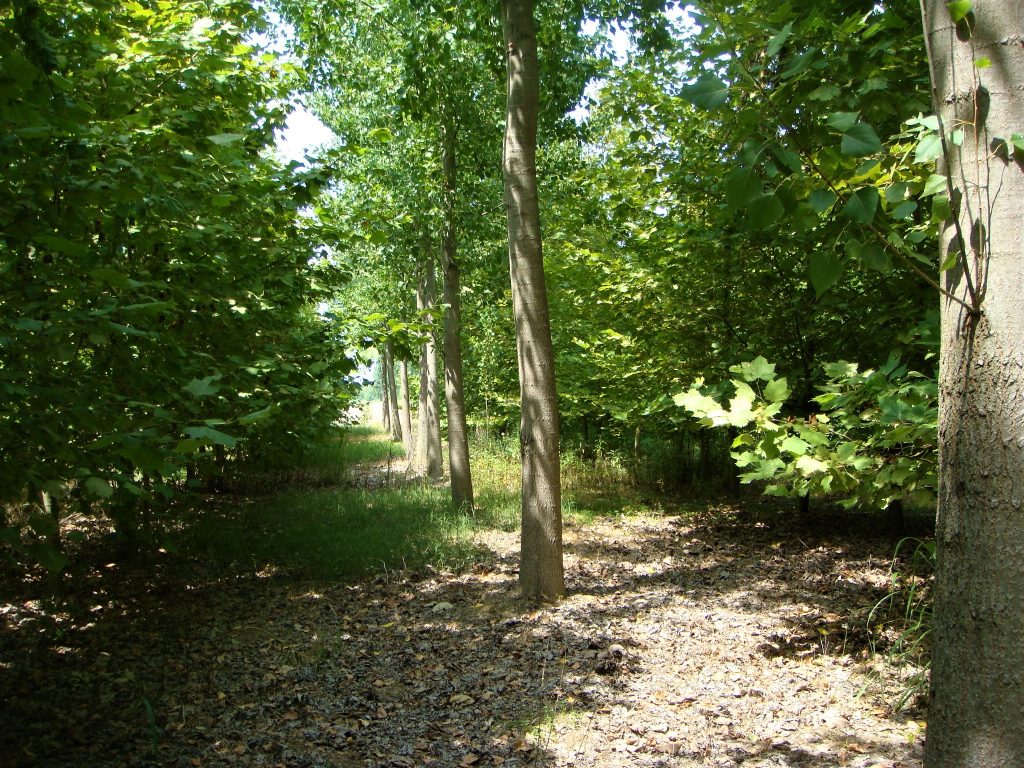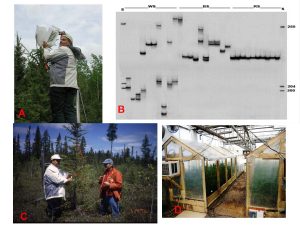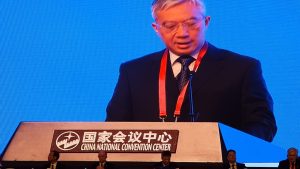Spotlight #81 – Developing evidence-based cases for planted forests
Spotlight #81 – Developing evidence-based cases for planted forests

Plantation forests get a bad rap.
That’s the assessment of Christophe Orazio, who is coordinator of the IUFRO Task Force (TF) on Resilient Planted Forests and, after having led the Planted Forests Facility of the European Forest Institute (EFI-PFF) until its closure in 2019, is now director of the European Institute for Cultivated Forest (IEFC).

Plantation forests get a bad rap.
That’s the assessment of Christophe Orazio, who is coordinator of the IUFRO Task Force (TF) on Resilient Planted Forests and, after having led the Planted Forests Facility of the European Forest Institute (EFI-PFF) until its closure in 2019, is now director of the European Institute for Cultivated Forest (IEFC).
IUFRO 125th Anniversary Congress Spotlight #55: Genetics research crucial to future forest health, adaptation, conservation and sustainable management
“The role genetics/genomics research can play in forest management is huge but, unfortunately, remains under-utilized,” said Dr. Om Rajora, Professor of Forest Genetics and Genomics at the University of New Brunswick, Canada.

A. Controlled pollination in black spruce to produce F3 progeny at Petawawa Research Forest; B. DNA fingerprints of 10 individuals each of white spruce (WS), black spruce (BS) and red spruce (RS) at a genic microsatellite showing genetic diversity; C. Sampling of old-growth and post-harvest second-growth black spruce to examine the genetic effects of forest harvesting and renewal practices in Manitoba (Rajora and Pluhar 2003, Theor. Appl. Genet. 106: 1203-1212); D. Testing of three-generation outbred pedigree of black spruce under ambient and elevated CO2 conditions for QTL mapping of traits related to acclimation and adaptation to climate change. All pictures were taken by Dr. Om Rajora or his associates.
“Genetics/genomics research can greatly assist the management of natural and planted forests by conserving healthy, productive, well-adapted and genetically diverse natural forest and developing high yielding tree varieties with desired traits for deployment in plantations,” he said.
Dr. Rajora is the organizer and coordinator of a session entitled Genetics and Genomics for Conservation, Climate Adaptation and Sustainable Management of Forests to be presented at the IUFRO 125th Anniversary Congress in Freiburg, Germany in September. Read more…
IUFRO Spotlight #41 – Sustainable Planted Forests to Meet Growing Global Needs

Plantation of Olga Bay Larch at Qingyuan in Liaoning Province, China. Plantations such as these will be an important source of roundwood in the future. (Photo by John Innes, Coordinator of IUFRO Task Force on Resources for the Future: Transformation in Forest Use)
The 2015 Global Forest Resources Assessments report from the UN Food and Agriculture Organization (FAO) noted that “…in planted forests, a new timber resource is continuing to be created … (that will) contribute significantly not only to future wood and energy supplies but … (also to) a range of wider social and environmental benefits…”
About 25 years ago, planted forests represented 4% of the world’s forested area. Today they represent almost 7%. But that 7% provides at least one-third of the world’s timber, so their importance should not be underestimated. Read more…
How far should we go “native”? Re-conceptualizing biodiversity restoration in urban forests
Keynote Speech by Professor Makoto Yokohari, The University of Tokyo, at the IUFRO Regional Congress for Asia and Oceania
Restoring biodiversity by reforesting urban fabrics is one of common urgent tasks for cities in the world in general and in the Asia and Oceania region in particular. After all, seven of the ten largest cities in the world are in this region. One of these cities is Tokyo. It accommodates 10 million people. More than 30 million people live in the national capital region; this is one third of the total population of Japan. However, despite the high number of population in Tokyo, one third of its area is mountainous, largely covered by natural and planted forest patches.

Professor Makoto Yokohari during his keynote speech. Photo: Gerda Wolfrum, IUFRO Headquarters
We should be aware of the fact that where you find megacities you often also find high biodiversity. Consequently, when talking about biodiversity, we cannot exclude cities as they often coincide with biological hotspots. Of course, the green spaces in cities do not only serve the purpose of biodiversity but they are also used by people for recreation. Urban greens are areas of human comfort. But how to balance between human comfort and biodiversity? Read more…
The crucial role of forests in combatting climate change
Session title: A-03 (76) Implications of the Paris Climate Change Agreement (CoP21) on Forests, Water and Soils
Moderator: Richard J. Harper, IUFRO Taskforce Coordinator “Forests, Soil and Water interactions”, Murdoch University, Australia
Tuesday, 25th of October 2016, 10:30-12-30 (306B)
Find more information on the IUFRO Task Force of Forests, Soil and Water interactions at: http://www.iufro.org/science/task-forces/forests-soil-water/

Tree at lake, Laos. Photo: all-free-download
The Paris Agreement established the ambitious goal to limit the global rise in temperature to below 2° C. This session took a look at the impact climate change as well as mitigation measures potentially have on forests, soil conservation and carbon mitigation. Read more…
Latest Progresses of Silviculture Research in China

Professor Zhang Shougong, CAF, on screen during the Opening Ceremony
Professor Zhang Shougong, Chinese Academy of Forestry, held the first keynote address at the IUFRO Regional Congress for Asia and Oceania on Monday, 24 October 2016.
As one of the leading scientists in silviculture and forest management in China, Professor Zhang Shougong, President of the Chinese Academy of Forestry, has long experience in establishment of planted forests and sustainable forest management. His research interests cover quality improvement and breeding of larch species, technologies for larch forest management and their application. Read more…
Interview with Professor Zhang Shougong, Chinese Academy of Forestry (CAF)

Professor Zhang Shougong, Chinese Academy of Forestry (CAF)
Keynote speaker at the IUFRO Regional Congress for Asia and Oceania –
Forests for Sustainable Development: The Role of Research
Professor Zhang, the IUFRO Regional Congress for Asia and Oceania 2016 is jointly organized by IUFRO and the Chinese Academy of Forestry. This is the first Congress of its kind to be held in the region of Asia and Oceania and will offer an extraordinary opportunity for enhancing forest science cooperation. You are one of the leading scientists in silviculture and forest management in China and have a long experience in the establishment of planted forests on the one hand, and sustainable forest management on the other hand. The Congress will particularly focus on these two areas with its themes “Planted forests for fostering a greener economy”, and “Sustainable forest management for enhanced provision of ecosystem services”. Read more…
Interview with Dr Elspeth MacRae, Scion, New Zealand
Keynote speaker at the IUFRO Regional Congress for Asia and Oceania – Forests for Sustainable Development: The Role of Research
Forests and the Bioeconomy: challenges and opportunities

Dr. Elspeth MacRae. Scion Photo
Innovative technologies for bio-energy, bio-materials and other products will be one of the major themes at the IUFRO Regional Congress for Asia and Oceania on 24-27 October 2016 in Beijing, China. Dr Elspeth MacRae leads wood and fibre processing activities, including biorefinery, biodiscovery and bioplastics at Scion, New Zealand. Her keynote speech will highlight state-of-the-art biotech research and the role of bioproducts. Read more…
Spotlight #15 – Planted forests’ roles: Different strokes for different oaks
Planted forests’ roles: Different strokes for different oaks
Planted forests are vital but vulnerable resources that can contribute in a sustainable fashion to some of humanity’s most pressing needs – poverty alleviation, food security, renewable energy, mitigation of and adaptation to climate change, and biodiversity conservation – as well as the preservation of natural forests.
These are among the findings in the recently published Summary Report of the 3rd International Congress on Planted Forests. It is based on outcomes from three scientific workshops and a plenary meeting that took place earlier this year.
Thirty-three countries have greater than 1 million hectares of planted forest area. Together these countries comprise 90% of the world’s 264 million hectares of planted forest which, in turn, equals almost 7% of the total global forest area. The report takes into account key research findings from Africa, Asia, Europe, Oceania, Latin America and North America related to vulnerability, viability and governance of planted forests.

